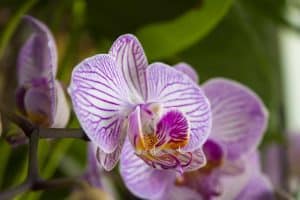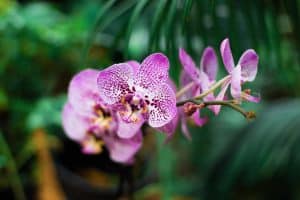What are the best pots for Phalaenopsis orchids?
Best Orchid Pots for Phalaenopsis – Beautiful flowers always equate to a much-loved plant. And that’s no different for orchids. Orchids are cherished by gardeners and non-gardeners alike the world over.
But orchids don’t come without their problems. And in large part, the problems arise because orchid care is rather different from the care given to other houseplants.
If you purchased a Phalaenopsis on impulse; if you received one as a gift; or if you’ve owned a Phalaenopsis for a number of years, perhaps you feel the need to provide the plant with a fresh container.
Orchids do have specific requirements, and that’s no different for Phalaenopsis. They need a container that drains well. They need a container that is able to provide support when the orchid is in flower.
Where do Phalaenopsis Orchids Come From?
Before we learn about choosing the right pot for your Phalaenopsis, let’s look into the orchids’ origins.
Phalaenopsis, as a species originates from Southeast Asia, inclusive of the Philippines where I am now. Have I seen Phalaenopsis growing naturally? Not that I can recall. But then, I’m not one to venture into the jungles in this part of the world. I admit to having a fear of snakes and poisonous spiders. Not to mention crocodiles (there are very few crocs living wild in the Philippines – they’ve been hunted almost to entire extinction).
In nature, the plant grows in trees, in soils that are extremely well aerated (humus, for example), on rock surfaces and in crevices. Typically, they’ll grow on rocks and in rock crevices when located near to running water.
Phalaenopsis was first described only in 1825. Dr. C.L. Blume, a Dutch botanist, came across the species when visiting Java, Indonesia.
Initially, Dr. Blume thought that what he was seeing was a group of butterflies. As it happens, it was not butterflies. Instead, it was a group of orchids. He named these orchids Phalaenopsis amabilis. The genus part of the name – Phalaenopsis – literally means ‘like a moth’ and is derived from ancient Greek. ‘Amabilis’ means ‘charming’ or ‘lovable’ and is of Latin origin.
Best Orchid Pots for Phalaenopsis – Choosing the Right Pot for Phalaenopsis
When you’re selecting a pot for your Phalaenopsis there are a few things to keep in mind:
Adequate drainage
The container should have plenty of holes around the sides as well as in the base. This is to allow for healthy airflow within the root zone and it helps to reduce any possibility of root rot occurring through consistently damp root-zone conditions.
Slightly larger
When choosing a pot for your Phalaenopsis go for one that is slightly larger than the pot it’s currently in. Orchids in general, Phalaenopsis being no different, prefer small-sized containers. Upsizing to a pot that is a mere one inch wider than the current pot is plenty enough.
Heavy enough
Seems a bit weird. Why would you need a heavy pot for an orchid?
Reason being is that when Phalaenopsis orchids flower the blooms are borne on flower spikes that generally reach 18 inches or more in height. As such, you’ll want a pot that is capable of supporting this top-heavy growth.
Short pot
For orchids, they prefer the shorter, dumpier pot rather than the longer, narrower pot. Why so? It’s because the roots grow outward and not downward. Further, a deeper pot well generally retains more moisture which is not the preference of Phalaenopsis orchids.
Most people who have Phalaenopsis at home choose a decorative type of pot that offers enough drainage. Either this or they utilize a system of double potting.
With respect to the latter, the Phalaenopsis will be grown in a grower pot – often one of those opaque pots that orchids are often sold in. This opaque/ clear pot has plenty of drainage holes. The opaque pot rests within the confines of a much more decorative exterior pot.
Actually, it’s quite often that when the Phalaenopsis is originally purchased it will come with the double-potted system.
There are pros and cons to each system.
The pros of the decorative pot alone are that the roots are not in view. The roots are not the most attractive part of any plant, at least in terms of appearance. Plus, you only need a single pot.
The con of the decorative pot alone is that it’s more difficult to check the root health. You can tell quite a lot by checking the health of Phalaenopsis roots in determining potential problems.
The pros of the double-potting system are that it’s easy to check out the roots. You can choose whichever decorative exterior pot you want. And you can swap decorative pots around with ease in accordance with preference of style and/or according to the season.
The downside of the double-potting system is that each time you wish to repot your Phalaenopsis you need to invest in two pots.
Best Orchid Pots for Phalaenopsis
If you’re not overly concerned about appearance, you may wish to go without the decorative pot. This means the roots will be able to absorb sunlight. They do the same in nature – the roots absorb sunlight and utilize it for photosynthesis (vegetative generation via sunlight).
The general rule for Phalaenopsis orchids is that they need to be repotted every year to two years.
How do you know when the right time is for repotting a Phalaenopsis?
You’ll notice the roots creeping through the drainage holes quite significantly. You’ll also notice that the growing medium no longer looks fresh. It’s thoroughly broken down.



